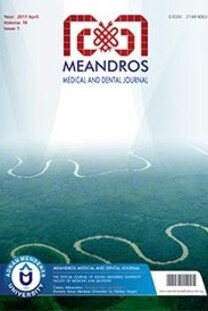YENİDOĞANIN İATROJENİK MİDE PERFORASYONU: OLGU SUNUMU
Yenidoğan, mide perforasyonu, iatrojenik, orogastrik sonda, mide aspirasyonu
Iatrogenic Neonatal Gastric Perforation: A Case Report
Neonatal, gastric perforation, orogastric tube, aspiration of stomach, iatrogenic,
___
- 1. Richard J Leone, Irwin H. Krasna. 'Spontaneous' neonatal gastric perforation: is it really spontaneous? J Pediatr Surg 2000;35:1066-9.
- 2. Kara CS, Ilce Z, Celayir S, Sarimurat N, Erdogan E, Yeker D. Neonatal gastric perforation: review of 23 years' experience. Surg Today 2004;34:243-5.
- 3. Grosfeld JL, Molinari F, Pharm D, Chaet M, Engum SA, West KW, Rescrla FJ, Scherer III LR. Gastrointestinal perforation and peritonitis in ifants and children: Experience with 179 cases over ten years. Surgery 1996;120:650-6.
- 4. Dillon PW, Cilley RE. Lesions of the stomach, In: Ashcraft KW, Murphy PJ, Sharp RJ, Sigalet DL, Snyder CL, editors, Pediatric Surgery. W. B. Saunders, Philadelphia, Pennsylvania, 2000:391-05.
- 5. Pelizzo G, Dubois R, Lapillonne A, Laine X, Claris O, Bouvir R, Chappuis JP. Gastric necrosis in newborn: a report of 11 cases. Pediatr Surg Int 1998;13:346-9.
- 6. Abadir J, Emil S, Nguyen N. Abdominal foregut perforations in children: a 10-year experience. J Pediatr Surg 2005;40:1903-7.
- 7. Ohshiro K, Yamataka A, Kobayashi H, Hirai S, Miyahara K, Sueyoshi N, Suda K, Miyano T. Idiopathic gastric perforation in neonates and abnormal distribution of intestinal pacemaker cells. J Pediatr Surg. 2000;35:673-6.
- 8. Izraeli S, Freud E, Mor C. Neonatal intestinal perforation due to congenital defects. Eur J Pediatr 1992;151:300-3.
- 9. Connelly KP, Shropshire LC, Salzberg A. Gastric Rupture Associated with Prolonged Crying in a Newborn Undergoing Circumcision. Clinical Pediatrics 1992;31:560-1.
- 10. HouckWS, Griffin JA. Sponteaneous linear tears of the stomach in the newborn infant. Ann Surg 1981;193:763-8.
- 11. Shaker IJ, Schaffer JA, James AE. Aerophagia: a mechanism for spontaneous rupture of the stomach. Am Surg 1973;39:619-23.
- ISSN: 2149-9063
- Yayın Aralığı: 4
- Başlangıç: 2000
- Yayıncı: Aydın Adnan Menderes Üniversitesi
YENİDOĞANIN İATROJENİK MİDE PERFORASYONU: OLGU SUNUMU
Sezen ÖZKISACIK, Barlas ETENSEL, Mesut YAZICI, Münevver TÜRKMEN, Harun GÜRSOY
KABUKİ MAKE-UP SENDROMU: OLGU SUNUMU
Önder YAVAŞCAN, Metin YUNUS, Orhan D. KARA, Nejat AKSU
AKUT VİRAL HEPATİT İNFEKSİYONLARININ YAŞ VE BİYOKİMYASAL ÖZELLİKLERİNİN İNCELENMESİ
Özden ERTUĞRUL, Bülent ERTUĞRUL, Ülker SONER, Fatma ÇAĞLAR
Meltem USLU, Göksun KARAMAN, Ekin ŞAVK, Neslihan ŞENDUR
POSTMENOPOZAL OSTEOPOROZDA RALOKSİFEN VE KALSİTONİN TEDAVİLERİNİN BİR YILLIK SONUÇLARI
Gülcan GÜRER, Ömer Faruk ŞENDUR, Ali AYDENİZ, Ali Hakan AYDEMİR
Sezen ÖZKISACIK, Mesut YAZICI, Mustafa Onur ÖZTAN, Barlas ETENSEL, Nil ÇULHACI, Mustafa Harun GÜRSOY
Berent DİŞCİGİL, M. İsmail BADAK, Uğur GÜRCÜN, Mehmet BOĞA, Erdem Ali ÖZKISACIK, Tuğrul Ü. GÜNEŞ
VENÖZ YETMEZLİK VE MALİGN EKRİN POROMA BİRLİKTELİĞİ
Cihangir ALİAĞAOĞLU, Sami KARAPOLAT, Mustafa ATASOY
ÇOK KISA SEGMENTLİ ÜLSERATİF KOLİT OLGUSU
Filiz YILDIRIM, Ali Önder KARAOĞLU, Vahit YÜKSELEN
